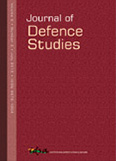Perceptions of Kashmiri Youth: Security Implications
The year 2011 was characterized by relative peace in the Kashmir Valley, especially when compared with the previous three years. A study undertaken on behalf of the Ministry of Home Affairs provides empirical indicators of the mood of the youth in six districts of the Valley. The study substantiates certain existing assessments based on environmental realities; however, it also raises other issues which come as a surprise to most. This article analyses five of these factors from a security perspective, based on the details that have emerged and other independent assessments.
- Vivek Chadha |
- April 2012 |
- Journal of Defence Studies





